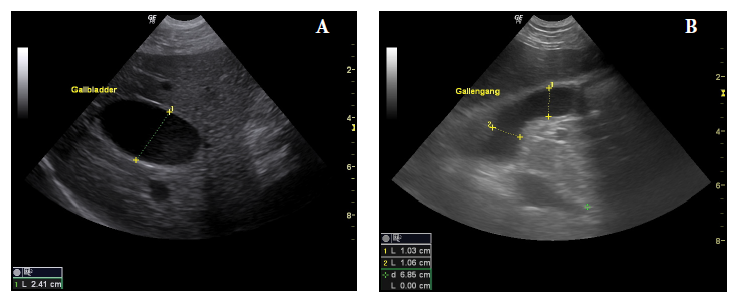Canine Infectious Diseases: Self-Assessment Color Review, Q&A 03
| This question was provided by CRC Press. See more case-based flashcards |

|
Student tip: This case is good for showing high quality ultrasound images. |
Case 03 is the same dog as in Case 02. A CBC revealed a hematocrit of 0.65 l/l (RI 0.35–0.58 l/l), a neutrophil count of 26.1 × 109/l (RI 5–16 × 109/l), and a band neutrophil count of 5.6 × 109/l (RI 0–0.5 × 109/l). On abdominal ultrasound examination, the liver was of normal size and echogenicity. The gallbladder was not enlarged. No abnormal contents, such as stones, could be visualized in the gallbladder, and the wall was not thickened (Image A). However, the common bile duct was distended and 1 cm in diameter (Image B). Because of gas in the gastrointestinal tract, the enlarged bile duct could not be followed to its duodenal entrance.
| Question | Answer | Article | |
| What form of icterus can be ruled out based on the results of the CBC? | Prehepatic icterus is unlikely, based on the high hematocrit. With normal liver function, massive numbers of erythrocytes must be destroyed for icterus to develop. Therefore, anemia is generally observed in icterus due to hemolysis.
|
Link to Article | |
| What is your assessment of the neutrophilia observed in this dog? | Neutrophilia can be due to glucocorticoids or stress, inflammation, or, in rare cases, leukemia. A significant inflammatory response due to a bacterial infection is most likely in this case given the magnitude of neutrophilia and the left shift. In contrast, a mild to moderate elevation of mature neutrophils often characterizes a stress leukogram, typically in association with a reduction in the eosinophil and lymphocyte counts. Granulocytic leukemia is a rare disorder and can be suspected when there is a very high number of neutrophils (50–100 × 109/l) without a significant left shift.
|
Link to Article | |
| What are reasons for distension of the common bile duct? | Two reasons for distension of the common bile duct are obstruction and inflammation.
|
Link to Article | |
| Which reason is more likely in this case, and what test would you perform to confirm your suspicion? | A complete obstruction of the common bile duct would cause distension of the intra- and extrahepatic biliary system upstream of the obstruction, as well as enlargement of the gallbladder. In this case, the gallbladder and intrahepatic biliary ducts were not distended. This imaging finding, together with the elevated rectal temperature and the significant left shift, makes an inflammatory cause of the bile duct distension more likely and should increase suspicion for bacterial cholangitis. To confirm a bacterial cholangitis, aspiration of bile for cytologic examination and aerobic and anaerobic bacterial culture is indicated.
|
Link to Article | |
To purchase the full text with your 20% discount, go to the CRC Press Veterinary website and use code VET18.
